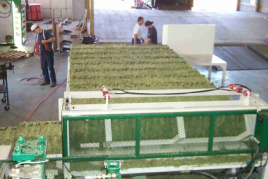| Project Scope:
Pedersen Planning Consultants was
obtained to examine the feasibility of developing an alfalfa
processing business enterprise in Greybull, Wyoming. The
feasibility study evaluated and available hay production within
a 4-county study area, identified potential domestic and
international markets, and determined start-up costs and working
capital requirements for the establishment, operation and
maintenance of an alfalfa processing facility and related
production equipment.
|

3400 Series Bale Compression System
Photo credit: Steffen Systems |
|
PPC initially examined the
capability of the alfalfa growers in the four-county area
surrounding the City of Greybull (Big Horn, Park, Washakie, and
Hot Spring Counties, Wyoming). Historical production data was
examined to determine recent alfalfa production volumes and
market prices. Available data was supplemented with a survey to
429 alfalfa producers in this four county area. Responses to
this survey provided insights concerning the motivation of
alfalfa growers to provide alfalfa hay to the compressed hay
operation, as well as more specific information concerning
potential volumes that might be available, the type of bales
produced.
PPC examined the domestic and
international dairy markets, as well as domestic horse hay
markets. Through the application of GIS software, available
data sets each of these markets were analyzed and segmented in
order to identify the more attractive geographical market
areas. Seventeen market destinations in the continental United
States and several Far East ports were identified and analyzed
in order to compare the transportation costs involved in
delivering compressed bales of alfalfa to these markets. Rail,
shipping and trucking rates were obtained to determine the most
economically efficient method to deliver the product to the end
user. PPC also determined costs associated with the
construction of a production site and facility, the purchase of
bale compression equipment and other operational equipment,
labor, and marketing. Potential market costs of compressed
alfalfa bales were calculated through a review of regional
market price data.
Anticipated costs and revenue
assumptions were input into a statistical model that generated
profit-loss and cash flow statements and cash flow projections
for the proposed alfalfa compression operation. The model was
used to compare four different marketing scenarios. Each
scenario emphasized a specific, but unique combination of
potential market channels for the sale of compressed alfalfa
hay. This approach enabled PPC to determine the most promising
market strategy in terms of potential return-on-investment to
the proposed business. |